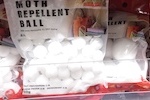Mothballs: Chemical Properties and Environmental Fate
1.800.858.7378npic@oregonstate.edu
We're open from 8:00AM to 12:00PM Pacific Time, Mon-Fri
A to Z

Mothballs: Chemical Properties and Environmental Fate
Mothballs in the U.S. contain high concentrations of either naphthalene or paradichlorobenzene. Both active ingredients are solid chemicals that slowly become fumes at room temperature. The fumes kill clothes moths when trapped inside sealed containers. Mothballs slowly disappear as they turn into gas and mix with the surrounding air. The time it takes a mothball to vaporize depends on many factors, including how many mothballs are present, the amount of air-flow around the mothballs, and the temperature.
Mothball fumes can stick to fabrics or clothing following storage, requiring items to be aired out and washed to remove the odor. Mothballs are not intended to be used outdoors as the ingredients can contaminate plants or soil, harm wildlife, contaminate water supplies and contribute to air pollution.
Additional Resources:
Naphthalene
- Naphthalene Technical Fact Sheet - NPIC
- ToxFAQs for Naphthalene - Agency for Toxic Substances and Disease Registry (ATSDR)
- Naphthalene Physicochemical Properties - International Programme on Chemical Safety (INCHEM)
- Naphthalene - EPA's Integrated Risk Information System
Paradichlorobenzene
- Paradichlorobenzene Technical Fact Sheet - NPIC
- Paradichlorobenzene Chemical and Physical Information - Agency for Toxic Substances and Disease Registry (ATSDR)
- International Chemical Safety Card - International Programme on Chemical Safety (INCHEM)
- 1,4-Dichlorobenzene (paradichlorobenzene) - EPA's Integrated Risk Information System
If you have questions about this, or any pesticide-related topic, please call NPIC at 800-858-7378 (8:00am - 12:00pm PST), or email us at npic@oregonstate.edu.



